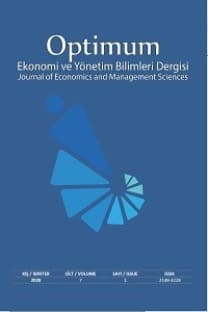Türkiye’de Bütçe Açığı, Kamu İç Borcu ve Gelir Eşitsizliği İlişkisi
Bu çalışmanın amacı Türkiye’de bütçe açığı, kamu iç borcu ve gelir eşitsizliği arasındaki ilişkileri tespit etmektir. Bu amaç doğrultusunda değişkenler arasındaki ilişkiler 1987-2018 dönemi temel alınarak Vektör Otoregresyon (VAR) yöntemi kullanılarak incelenmektedir. Ampirik sonuçlar, Türkiye’de hem bütçe açığından hem de bütçe açığının finansman yöntemi olarak kullanılan kamu iç borçlarından gelir eşitsizliğine doğru tek yönlü nedensellik olduğuna dair kanıt sunmaktadır. Benzer şekilde bu ilişki VAR modelinden elde edilen etki tepki fonksiyonlarında da görülmektedir. Bütçe açığı ve kamu iç borç stokundaki bir şokun gelir eşitsizliği üzerinde pozitif etkileri olduğu söylenebilir. Bunun yanı sıra teorik beklentilerle uyumlu olacak şekilde bütçe açığının da kamu iç borcu stoku üzerinde uzun dönemli pozitif etkisinin varlığına yönelik kanıtlara ulaşılmaktadır. Elde edilen bu sonuçlar ise kamu iç borç stokundaki artışın gelir eşitsizliğini arttırıcı etkiye sahip olduğunu ileri süren teorik görüşleri Türkiye için destekler niteliktedir.
Anahtar Kelimeler:
Bütçe Açığı, Kamu İç Borcu, Gelir Eşitsizliği, Türkiye
The Relationship between Budget Deficit, Public Domestic Debt and Income Inequality in Turkey
The aim of this study is to determine the relationship between budget deficit, public debt and income inequality in Turkey. For this purpose, the relationships between these variables are examined using the Vector Autoregression (VAR) method for 1987-2018 period. The empirical results provide evidence that there is a one direction causality both from budget deficit and from the domestic debt used as the financing method of the budget deficit to income inequality in Turkey. Similarly, this relationship is observed in the impulse response functions obtained from the VAR model. It can be said that a shock in the budget deficit and public domestic debt stock have increasing effects on income inequality. In addition, there is evidence of the long-term positive impact of the budget deficit on the public domestic debt stock, in line with theoretical expectations. Accordingly, these results support the theoretical views that argue that the increase in public domestic debt stock has an effect on increasing income inequality for Turkey.
Keywords:
Budget Deficit, Public Domestic Debt, Income Inequality, Turkey,
___
- Akram, N. & Hamid, A. (2016). Public debt, income inequality and macroeconomic policies: evidence from South Asian Countries. Pakistan Journal of Social Sciences (PJSS), 36(1), 99-108.
- Arslan, F. P. (2019). Public debt and income inequalıty in Turkey. Journal of Research in Economics, 3(2), 91-109.
- Bakkal, S. ve Gürdal, T. (2007). İç borçlanmanın Türkiye ekonomisi üzerine etkileri. Akademik İncelemeler Dergisi (AID), 2(2), 147-173.
- Barro, R. J. (1974). Are government bonds net wealth?. Journal of Political Economy, 82(6), 1095-1117.
- Bedir, S. ve Karabulut, K. (2011). İç borçların gelir dağılımı üzerine etkileri. Atatürk Üniversitesi İktisadi ve İdari Bilimler Dergisi, 25(1), 13-30.
- Churchman, N. (2001). David Ricardo on public debt. Palgrave: New York.
- Dişbudak, C. ve Süslü, B. (2007). Türkiye'de kişisel gelir dağılımını belirleyen makroekonomik faktörler. Ekonomik Yaklaşım, 18(65), 1-23.
- Emirmahmutoglu, F. & Kose, N. (2011). Testing for Granger causality in heterogeneous mixed panels. Economic Modelling, 28(3), 870-876.
- Enders, W. (2015). Applied Econometric Time Series. Fourth Edition Chichester, West Sussex: Jhon Wiley & Sons.
- Ertekin, Ş. (2018) Kamu borçlarının gelir dağılımı üzerine olası etkileri: Oecd ülkeleri üzerine panel nedensellik analizi. Yönetim ve Ekonomi Araştırmaları Dergisi, 16(4), 334-348.
- Hager, S. B. (2016). Public debt, inequality and power. The making of a modern debt state, ISBN 978-0-520-96042-8, University of California Press, Oakland, CA.
- İlgün, F. (2016). Mali disiplin ve mali konsolidasyon programlarının gelir dağılımı üzerindeki etkisi: Oecd ülkelerine yönelik panel veri analizi. Yönetim ve Ekonomi Araştırmaları Dergisi, 14(4), 222-244.
- Johansen, S. & Juselius, K. (1990). Maximum likelihood estimation and inference on cointegration—with applications to the demand for money. Oxford Bulletin of Economics and Statistics, 52(2), 169-210.
- Jong-Il, Y. & Dutt, A. K. (1996). Government debt, income distribution and growth. Cambridge Journal of Economics, 20(3), 335-351.
- Pesaran, H. H. & Shin, Y. (1998). Generalized impulse response analysis in linear multivariate models. Economics Letters, 58(1), 17-29.
- Piketty, T. (2014). 21. yüzyılda kapital. İş Bankası Kültür Yayınları: İstanbul.
- Prechel, H. (1985). The effects of exports, public debt, and development on income inequality. The Sociological Quarterly, 26(2), 213-234.
- Salti, N. (2015). Income inequality and the composition of public debt. Journal of Economic Studies, 42(5), 821-837.
- Sims, C. A. (1980). Macroeconomics and reality. Econometrica: Journal of the Econometric Society, 48(1), 1-48.
- Solt, F. (2009). Standardizing the world income inequality database. Social Science Quarterly, 90(2), 231-242.
- You, J. & Dutt, A. (1996). Government debt, income distribution and growth. Cambridge Journal of Economics, 20(3), 335-351.
- Yayın Aralığı: Yılda 2 Sayı
- Başlangıç: 2014
- Yayıncı: -
Sayıdaki Diğer Makaleler
Etem ERGEÇ, Bengül Gülümser KAYTANCI
İkili Bankacılık Sisteminde İslami Bankacılık ve Ekonomik Büyüme
Ekonomik Gelişmişliği Etkileyen Bilgi Ekonomisi Değişkenlerinin Veri Madenciliği ile Belirlenmesi
Mehpare TİMOR, Gonca YÜZBAŞI KÜNÇ
Lojistik ve Tedarik Zinciri Yönetiminde İşbirlikçi Paradigma
Sosyal Hizmet Uzmanlarının Çalışma Yaşamlarında Karşılaştıkları Sorunlar: Burdur İli Örneği
Bilgesu ÇÜM, Cemile Zehra KÖROĞLU
Sağlık Harcamaları ile Ekonomik Büyüme Arasındaki İlişki: Türkiye’den Kanıtlar
Türkiye’de Bütçe Açığı, Kamu İç Borcu ve Gelir Eşitsizliği İlişkisi
Türkiye’de Mali Demokrasi: 2010-2019 Dönemi İçin Bir İnceleme
